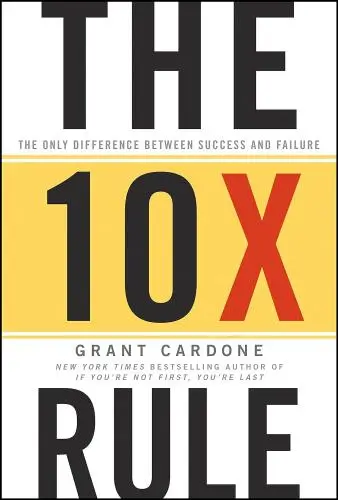
UNSCRIPTED
Life, Liberty, and the Pursuit of Entrepreneurship
What's it about?
UNSCRIPTED by MJ DeMarco is a guide that shatters the conventional chains of a scripted life. DeMarco empowers readers to escape the dreary 9-5 cycle, urging them to seize control of their financial destinies. Through compelling insights and actionable advice, this book teaches how to create a life of wealth, freedom, and fulfillment, beyond the restrictive norms of society. It's a blueprint for those daring to live life on their own terms, making it a must-read for aspiring entrepreneurs and dreamers alike.
About the Author
MJ DeMarco is an entrepreneur and author, best known for his book "The Millionaire Fastlane." His work focuses on debunking traditional financial advice, advocating for wealth creation through entrepreneurial ventures. DeMarco's writing style is direct and engaging, emphasizing action over conventional paths to financial success.
10 Key Ideas of UNSCRIPTED
Embrace the Fastlane Mindset: Shifting Gears from Time Trading to Value Creation
The core idea is to move away from traditional employment, where income is directly tied to time spent working (the Slow Lane), and instead, focus on creating systems or assets that generate income independently of time.
This involves leveraging business, investments, or intellectual property to produce scalable and sustainable wealth.
The reasoning behind this approach is that there's a limit to how much one can work and, consequently, earn in a time-for-money trade.
By focusing on value creation, you're not bound by the 24 hours in a day, allowing for exponential growth in income.
Learn DeeperIdentify Your Unique Value Proposition: Think about what unique skills, knowledge, or solutions you can offer. This could be anything from a unique product idea to a service that addresses a specific need.
Start Small and Scale: Begin with a small project or business that requires minimal investment. Focus on building a strong foundation and gradually scale up as you gain more confidence and resources.
Leverage Technology: Use technology to automate processes, reach a wider audience, and manage resources more efficiently. This could involve setting up an online store, using social media for marketing, or employing software to handle customer service.
Invest in Assets: Look for opportunities to invest in assets that generate passive income. This could be real estate, stocks, or even creating digital products that sell over time without additional effort.
Continuously Learn and Adapt: Stay informed about trends and advancements in your field. Be willing to adapt your strategy and offerings to meet changing market demands and leverage new opportunities.
- Example
Creating an online course on a topic you're an expert in. Once the course is created and uploaded to a platform, it can generate income each time someone enrolls, without requiring your direct time investment for each sale.
- Example
Developing a mobile app that addresses a common problem or need. After the initial development phase, the app can continue to generate revenue through in-app purchases or advertising, regardless of how much time you personally spend on it.
Identify Your Market's Needs: Solving Problems as a Pathway to Wealth
Success in the Fastlane hinges on identifying and solving problems for a specific market.
This tactic involves deeply understanding your target audience, recognizing their pain points, and offering a unique solution that addresses those needs.
The rationale is that businesses built on solving real-world problems tend to have a stronger value proposition, leading to higher customer satisfaction, loyalty, and referrals.
By focusing on problem-solving, you ensure your business remains relevant and in demand.
Learn DeeperIdentify Pain Points: Start by engaging with your target market through surveys, social media, or direct conversations. Ask open-ended questions to uncover their challenges and frustrations.
Validate Your Solution: Before fully committing to your solution, test it with a small segment of your target market. This can be done through prototypes, beta versions, or pilot programs to gather feedback and ensure it effectively solves the problem.
Differentiate Your Offer: Look at how current solutions are failing to meet the market's needs and position your offer as a unique alternative. Highlight what sets your solution apart in terms of features, benefits, or customer experience.
Educate Your Market: Use content marketing, workshops, or webinars to educate your target audience about the problem you're solving. This not only builds trust but also positions your brand as an authority in the space.
Iterate Based on Feedback: Continuously seek feedback from your customers and use it to refine and improve your solution. This iterative process ensures your product or service evolves in line with your customers' needs.
- Example
A tech entrepreneur notices that local small businesses struggle with managing online orders efficiently. They develop a user-friendly app that integrates all major online ordering platforms into one dashboard, simplifying the process for business owners.
- Example
A fitness coach identifies that most of her clients fail to stick to their workout routines because they find them boring and repetitive. She creates a series of fun, high-energy group classes that incorporate dance and functional training, making workouts enjoyable and increasing client retention.
Commandment of Control: Steering Your Own Ship
This concept emphasizes the importance of having direct control over your business and income sources.
It suggests avoiding scenarios where your financial fate is in the hands of others, such as being reliant on a single employer or platform.
The argument for maintaining control is that it reduces risk and increases stability, allowing you to make strategic decisions that align with your long-term goals.
Control ensures that you can pivot, adapt, and scale your business according to market demands without external limitations.
Learn DeeperEvaluate Your Current Situation: Take a moment to assess how much control you currently have over your income sources. Are you too dependent on a single employer or platform? Start brainstorming ways to diversify your income.
Start Small with Side Projects: Begin with a small project or business that you can manage alongside your primary job. This could be anything from freelance work to an online store. The key is to choose something that interests you and has growth potential.
Learn to Delegate Wisely: As you grow, learn the art of delegation. Hiring freelancers or employees for tasks outside your expertise allows you to focus on strategic decisions and business growth, while still maintaining overall control.
Educate Yourself Continuously: Stay informed about market trends, new tools, and strategies in your field. Knowledge is power, and staying updated will help you make informed decisions to steer your business effectively.
Build a Network of Support: Surround yourself with mentors, peers, and professionals who can offer advice, share experiences, and provide support. A strong network can be invaluable for gaining insights and discovering new opportunities.
- Example
A graphic designer working for a company decides to start offering freelance services during evenings and weekends. Over time, they build a diverse client base, reducing their dependency on their day job for income.
- Example
An IT professional creates a tech blog and YouTube channel to share their knowledge. They monetize these platforms through ads, sponsorships, and affiliate marketing, creating additional income streams that they control.
The Commandment of Scale: Expanding Your Impact for Greater Profit
Scaling your business means increasing its revenue potential without a corresponding rise in operational costs.
This can be achieved through various strategies like automating processes, expanding to new markets, or leveraging technology.
The reason scaling is crucial is that it allows your business to serve more customers and generate more income without being constrained by physical or personal limits.
Scaling transforms a small operation into a significant player, multiplying its impact and profit.
Learn DeeperIdentify tasks that can be automated within your business. This could include customer service responses, billing, or social media posting. Automation tools can significantly reduce the time spent on these tasks, allowing you and your team to focus on more strategic activities.
Explore new markets or niches where your product or service could be introduced. This doesn't necessarily mean geographical markets; it could also refer to different customer segments within your current market. Conduct market research to identify these opportunities.
Leverage technology to enhance your product or service delivery. This could mean adopting new software to improve your service efficiency, using online platforms to reach a wider audience, or integrating advanced analytics to better understand customer behavior and preferences.
Develop scalable products or services. Focus on offerings that require minimal customization and can be easily replicated. This might involve creating digital products, standardizing your service packages, or developing a training program that allows others to deliver your service effectively.
Build a strong online presence. Utilize social media, content marketing, and SEO strategies to attract and engage a larger audience. An effective online presence can help you reach potential customers across the globe without significant additional costs.
- Example
A graphic design business automates its client onboarding process with an online form that collects all necessary information, allowing the designer to start work immediately without back-and-forth emails.
- Example
A local bakery expands its market by offering online ordering and nationwide shipping for its most popular items, leveraging social media to reach potential customers outside its geographic location.
The Commandment of Need: Focusing on What People Buy, Not What You Think They Should
This principle advises entrepreneurs to base their business ideas on actual market demands rather than personal assumptions or passions.
It involves conducting thorough market research to understand what products or services people are willing to pay for.
The logic is straightforward: businesses that cater to existing needs have a higher chance of success because they're aligned with consumer behavior and preferences.
By focusing on need, you ensure your business has a ready and willing market.
Learn DeeperIdentify a Need: Start by observing your surroundings or think about the complaints you often hear from people. What are some common problems or needs that people express? This could be anything from a lack of affordable, healthy fast food options to difficulties finding eco-friendly household products.
Conduct Market Research: Use surveys, interviews, and online tools to gather data about potential customers' preferences, buying habits, and unmet needs. This will help you understand if there is a genuine demand for the solution you're considering.
Analyze Competitors: Look at businesses offering similar products or services. What can you offer that's different or better? Understanding your competition will help you find your unique selling proposition (USP).
Test Your Idea: Before fully committing, test your product or service on a small scale. This could be through a pilot program, a minimal viable product (MVP), or a prototype. Gather feedback and be prepared to iterate based on what you learn.
Focus on Solving the Problem: Always keep the core need in mind. Your business should aim to solve this problem as effectively as possible. This might mean refining your product or service based on customer feedback or changing your approach as you learn more about what works.
- Example
A person notices that their community lacks accessible, affordable tutoring services for students. They conduct surveys among parents and find a strong demand for such a service. They start a tutoring business that offers flexible, affordable sessions, quickly gaining popularity among busy families.
- Example
An entrepreneur realizes that many people are looking for sustainable, eco-friendly cleaning products but find them too expensive or hard to find. They create a line of affordable, eco-friendly products and use their market research to target their marketing efforts effectively, leading to a successful launch and steady growth.
Deeper knowledge. Personal growth. Unlocked.
Unlock this book's key ideas and 15M+ more. Learn with quick, impactful summaries.
Read Full SummarySign up and read for free!
UNSCRIPTED Summary: Common Questions
"Life isn't about 'finding' yourself, life is about creating yourself." This powerful quote from UNSCRIPTED by MJ DeMarco sets the tone for a no-nonsense approach to living life on your own terms. The book challenges the conventional wisdom of blindly following the traditional "script" of going to school, getting a job, and retiring at 65. DeMarco presents a compelling case for breaking free from societal expectations and designing a life of true freedom and fulfillment through entrepreneurship.
What had me hooked were the real-life examples and practical strategies shared throughout the book, illustrating how individuals can break out of the scripted life and forge their paths to wealth and success. DeMarco's bold perspective on the dangers of the scripted life and the power of taking control of one's financial future left me inspired and motivated to rethink my own journey.
Overall, UNSCRIPTED is a must-read for anyone feeling stuck in the rat race and seeking a roadmap to financial independence and personal autonomy. If you enjoyed books like "Rich Dad Poor Dad" by Robert Kiyosaki, you'll appreciate the game-changing insights found in UNSCRIPTED.
Experience Personalized Book Summaries, Today!
Discover a new way to gain knowledge, and save time.
Sign up for our 7-day trial now.
No Credit Card Needed

Similar Books
Trending Summaries

Peak
Anders Ericsson
Never Split the Difference
Chris Voss
Smart Brevity
Jim VandeHei
The Psychology of Money
Morgan Housel
The First 90 Days
Michael D. Watkins
Atomic Habits
James Clear
Thinking, Fast and Slow
Daniel Kahneman
The Body Keeps the Score
Bessel van der Kolk M.D.
The Power of Regret
Daniel H. Pink
The Compound Effect
Darren HardyNew Books

The ^AOxford Handbook of Job Loss and Job Search
Ute-Christine Klehe PhD
Job Interviews For Dummies®
Joyce Lain Kennedy
Job Interviews In A Week
Alison Straw
Handbook of Career Development
Gideon Arulmani
The Art of Spending Money
Morgan Housel
$100M Offers
Alex Hormozi
A Candle for Kiri
Edna Mae Holm
Principles of Marketing, Global Edition
Gary Armstrong
Serpent Rising: The Kundalini Compendium
Neven Paar










